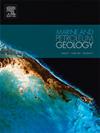Occurrence and formation mechanism of silicate-interlayered iron minerals in hydrate-bearing sediment
IF 3.7
2区 地球科学
Q1 GEOSCIENCES, MULTIDISCIPLINARY
引用次数: 0
Abstract
In this investigation, the geochemical properties of carbonates and iron sulfides in bulk sediment were systematically investigated to elucidate the original depositional characteristics and post-seepage alterations in hydrate-bearing sediments from the mid-continental slope of the Shenhu area, South China Sea. The paleo-sulfate methane transition zone at site W07B was delineated using proxies for carbonate (elevated dolomite levels and δ13C-TIC exhibiting negative bias) alongside indicators for iron sulfide (enhanced pyrite levels and δ34S-pyrite showing positive bias) between 132 and 151mbsf. Beyond the typical marine sediment inclusion such as framboid pyrite and foram-shell-filled pyrite, this research reveals a notable occurrence of interlayered silicate pyrite and interlayered siderite, as revealed by EDS and Raman spectrum, marking the novel documentation of such iron-rich secondary minerals in hydrate-bearing sediments. The formation mechanisms and conditions for these authigenic, iron-rich minerals are explored, with their formation linked to the microbial weathering of iron-rich silicate minerals during methane metabolism by entities like methanogens and sulfate-reducing bacteria. The genesis of these minerals is fundamentally driven by the presence of methane-rich fluids and microbial activities. Additionally, the weathering of silicates results in unique secondary mineral assemblages within various chemical zones, where interlayered pyrite appears in the sulfate reduction zone, and interlayered siderite forms within the Fe-Mn reduction zone and/or methanogenic zone. This study shed light on the complex interactions between microbial activities and sediment geochemistry in hydrate-bearing marine settings.
求助全文
约1分钟内获得全文
求助全文
来源期刊

Marine and Petroleum Geology
地学-地球科学综合
CiteScore
8.80
自引率
14.30%
发文量
475
审稿时长
63 days
期刊介绍:
Marine and Petroleum Geology is the pre-eminent international forum for the exchange of multidisciplinary concepts, interpretations and techniques for all concerned with marine and petroleum geology in industry, government and academia. Rapid bimonthly publication allows early communications of papers or short communications to the geoscience community.
Marine and Petroleum Geology is essential reading for geologists, geophysicists and explorationists in industry, government and academia working in the following areas: marine geology; basin analysis and evaluation; organic geochemistry; reserve/resource estimation; seismic stratigraphy; thermal models of basic evolution; sedimentary geology; continental margins; geophysical interpretation; structural geology/tectonics; formation evaluation techniques; well logging.
 求助内容:
求助内容: 应助结果提醒方式:
应助结果提醒方式:


